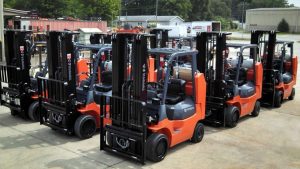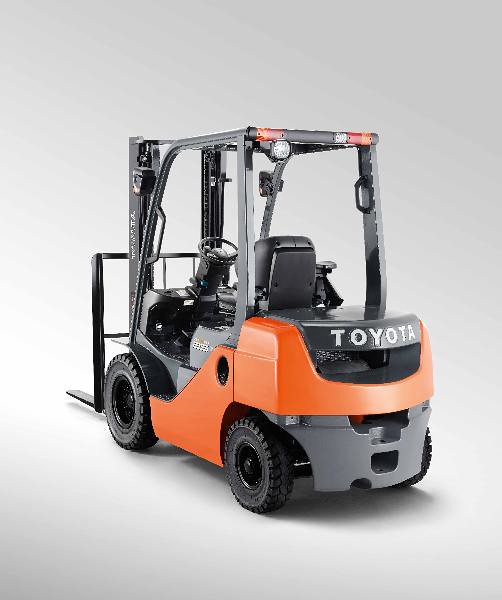Counterbalance Forklifts
No all forklifts are the same. To prove the point, let’s take a look at a counterbalance forklift and determine advantages and disadvantages to their use in your warehouse.
What Is A Counterbalance Forklift?
The difference between a counterbalance forklift and all other styles of lifts is that the counterbalance features a counterweight to offset the weight the fork lifts. It includes a heavy cast iron weight attached to the rear of the lift. Commonly, the battery pack of an electric lift serves as part of the counterbalance system. When a large version of a counterbalance lift is used, the soft rubber rear tires are filled with chloride, or salt water, to add weight to the rear portion of the lift. The added weight improves the lifting capacity of the lift.
Some forklifts need a counterweight to balance products that the forklift is lifting. Certain precautions need to be used when operating this kind of lift. Because of forklift lifts heavy objects into the air, the rear portion of the lift becomes very light due to the rotation of the weight over the front tires. A counterbalance forklift places weight on the rear of the lift to provide a counterbalance so that the machine won’t tip over on the front axle.
Drivers of counterbalance forklifts need to take precautions because they can lift a weight heavy enough to make the lift become too light on the rear tires. Obviously, this is a dangerous condition. So, it is still possible for an operator of a counterbalance forklift to overload the forks that can result in a rollover accident.
So, it is essential that a counterbalance forklift operator knows the lifting capacity of the lift he is driving and also knows how to estimate weight of a load on the lift. The hydraulic system of the counterbalance forklift is powerful enough to lift a greater capacity the forklift is rated to lift safely. It is certainly not the time for a forklift operator to know that the load he has hoisted into the air is excessive. When the weight of a load is unknown, then it is common for a forklift driver to raise the load only slightly at first, then suddenly apply the brakes while rolling forward. If the driver senses that the rear of the forklift rising should be a warning that a larger and heavier forklift should be used to lift the load.
Drivers of counterbalance forklifts should be aware that they need a larger space in which to maneuver their machine. It is not uncommon for a counterbalance forklift to often bump into racks and other objects as the driver tries to maneuver it through a narrow corridor in order to place a load on a rack or shelf. This is why many counterbalance forklifts feature rounded corners on their rear. The corners assist the machine in turning more sharply in tight spaces.
Why Do Warehouses Use Counterbalance Forklifts?
Warehouses like using this style of forklift because they can serve a multipurpose. The truck can be used on docks or in aisles at least 10 to 12 feet wide. These trucks can stake pallet loads up to 4 levels high. The truck is most often used for shipping and receiving. It is also ideal for moving pallets to and from storage. These trucks are categorized as Class 1 trucks for material handling.

Counterbalance Forklifts feature a counterweight to offset the weight the fork lifts. *Credit: Bahrns ToyotaLift Photo
Counterbalanced forklifts come in an assortment of capacities from 2,000 to 6,000 pounds. Fork lengths on this type of lift can vary and masts are available in a variety of heights. Consider these features when determining whether to use a counterbalanced lift in your warehouse.
To determine the proper mast, warehouse fleet managers should consider these points:
• Overall collapsed height.
• Elevated height.
• Extended height.
• Hydraulic functions like side shirt or mast tilt.
A counterbalance forklift should be considered when using appropriate attachments, cross-docking, and dock-to-stock operations are required. It is also ideal when the unit load or pallet locations are below 260-inches.
Counterbalanced forklifts are not always ideal for all warehouse operations. For example, they’re not good when the lift is used for case or piece picking, in narrow or very narrow aisles, or for load storage and retrieval above 260-inches.
Advantages To Using Electric Counterbalance Forklifts
Using this type of forklift provides a plethora of advantages including:
• Cost savings.
• No performance reduction
• Improved health and safety.
• Reduces carbon footprint.
• Lower routine maintenance
• Less noise.
(Sources: wisegeek.com, hlifttrucks.co.uk, and raymondhandling.com)

